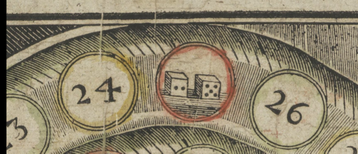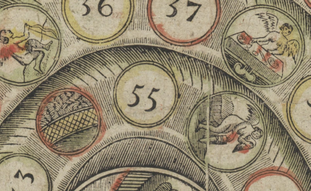Giochi dell'Oca e di percorso
(by Luigi Ciompi & Adrian Seville)
(by Luigi Ciompi & Adrian Seville)

|
Giochi dell'Oca e di percorso
(by Luigi Ciompi & Adrian Seville) |

|
 |

Torna alla ricerca giochi (back to game search) |
 |
| Nieuw (Het) Vermaakelyk Slangespel of anders genaamd koninglyke tydkorting van Cupido | ||
 |
Versione stampabile
 |
Invia una segnalazione

|
             |
primo autore: | Bouwens A. |
| secondo autore: | Bouwens A. | |
| anno: | 1819/42 | |
| luogo: |
Olanda-Amsterdam |
|
| periodo: | XIX secolo (1°-2°/4) | |
| percorso: | Percorso di 63 caselle numerate | |
| materiale: | carta (paper) (papier) | |
| dimensioni: | 474X423 | |
| stampa: | Stampa su legno (bois gravé) (woodcut) | |
| luogo acquisto: | ||
| data acquisto: | ||
| dimensioni confezione: | ||
| numero caselle: | 63 | |
| categoria: | Amore, matrimonio e famiglia | |
| tipo di gioco: | Gioco di percorso | |
| editore: | Wendel en Zoon J. | |
| stampatore: | Te Amsterdam by J. Wendel en Zoon Boekdrukker op Anjeliersgragt No 148 | |
| proprietario: | Rijksmuseum | |
| autore delle foto: | Rijksmuseum | |
| numero di catalogo: | 2519 | |
| descrizione: |
Gioco di 63 caselle numerate, spirale, orario, centripeto che ha la forma di un serpente. Questo gioco anticipa per grafica un gioco della metà del XVIII secolo realizzato da Robert Sayer, mercante di carte e di stampe a cui successero nel 1794 Robert Laurie&James Whittle e nel 1813 Richard H. Laurie. L'antico gioco egiziano del serpente, di forma spirale, può aver ispirato molti giochi di società, ma le regole rimangono ancora sconosciute. Nel Gioco del Serpente alla casella 63 si può osservare: - tre coppie di amanti con Cupidi fra le nuvole (De Jode Pieter 1620ca / Veuve Petit 1640ca); - Cupido che affila la punta della sua freccia in un giardino (Laurie&Whittle, 1794 / Lumsden, 1810-1830ca / R. H. Laurie,1850ca); - una coppia contadina che balla accompagnata da un Cupido che suona uno strumento (Visscher, 1625ca / Garrett, 1690ca / Dicey, 1736-40 / Rynders H. Erve 1790-1800 / Wendel en Zoon J. 1819-42); - un Cupido da solo con il suo arco (Carington Bowles 1756 / Bowles&Carver 1763-1780ca); - due personaggi che giocano a tavola in presenza di un Cupido (Anonimo XVIII° secolo). In questo esemplare alla casella 63 troviamo una coppia di contadini che balla. In basso:"Te Amsterdam by J. Wendel en Zoon Boekdrukker op Anjeliersgragt No 148". In corrispondenza delle caselle 16 - 17: "A. Bouwens". Non esiste una versione italiana di questo gioco ad esclusione de "Il Novo et Piacevol Gioco del Giardin d’Amore (Arch. n°1105) che a parità di tema si gioca però come il gioco della civetta. REGOLE: in basso. CASELLE: mute. Cas. 5) Ponte; Cas. 7) Cupido; Cas. 12) Sedia; Cas. 14) Cupido; Cas. 16) Dadi (6+1); Cas. 18) Cupido; Cas. 21) Cupido; Cas. 25) Dadi (5+2); Cas. 28) Cupido; Cas. 30) Fontana; Cas. 35) Cupido; Cas. 38) Cupido; Cas. 42) Cupido; Cas. 43) Dadi (3+4); Cas. 46) Labirinto; Cas. 49) Cupido; Cas. 54) Bosco; Cas. 56) Cupido; Cas. 59) Bara; Cas. 63) Coppia contadina che balla accompagnata da un Cupido che suona uno strumento. NOTA: vedi esemplari Arch. n°862, Arch. n°1240, Arch. n°1309, Arch. n°2342, Arch. n°2354, Arch. n°2487, Arch. n°2488, Arch. n°2489, Arch. n°2490, Arch. n°2518. REFERENZA 1 Spiraalvormig bordspel met linksboven de kop van de slang voorzien van een kroon, rechtsboven zijn staart. Over de hele slang ronde vakjes genummerd van 1 tot en met 63, enkele met voorstellingen van putti. In het midden een ovaal met afbeelding van een dansend boerenpaar, tussen hen in een musicerende putto. In de ondermarge de spelregels in twee kolommen. (Rijksmuseum) REFERENZA 2 (...) De Jode’s Game of Cupid was copied between 1625-‘40 by Claes Jansz. Visscher in Amsterdam. The title was changed into ‘The new game of snake, otherwise called the royal pastime of Cupid’. The rules only give the basics; no mention is made of the numerological signifance nor of the additional favourable throwing of the number 7. The icons are all identical although Visscher left out the meaningless castle of space 4. He slightly changed the appearance of the snake by leaving out the twist behind its head and by moving the curled tail from the centre to upper right, making the image more symmetric. The biggest change is in the central image. Where Pieter de Jode showed a garden of love with elegant couples, Visscher depicted a dancing peasant couple with a matching Cupid, who is making music with some crude kitchen tools. In the accompanying rules this garden is called ‘the peasant garden of Cupid’ [den boertigen Hoff van Cupido]; besides literally referring to the depicted peasants, the word boertig also had the connotation of farcical or ludicrous. Visscher herewith aimed at a market of the Dutch upper class, where this connotation was in vogue. Visscher also doubtless referred to popular songbooks such as G.A. Bredero’s Boertigh, Amoreus, en Aendachtigh Groot Liedboeck, first published in Amsterdam in 1622, which addressed the same audience. In a later, close copy of Visscher’s print the central image is replaced with an elegant couple, playing the game seated at a table, although in the rules the boertigen Hoff remained. Visscher’s Game of Snake was copied and reissued several times until the mid-nineteenth century, all with the peasant dance at centre. (...) (Marjolein Leesberg) Exhibitions: |
|
| bibliografia: |
1) ALLEMAGNE, Henry-René D’: "Le noble jeu de l’oie en France, de 1640 à 1950", Ed. Grund, Parigi 1950. 2) BECKER, Udo: "The Continuum Encyclopedia of Symbols", New York, Bloomsbury Publishing, 2000. 3) WHITEHAUSE, F.R.B.: "Table Games of Georgian and Victorian Days", London, Peter Garnett, 1951. 4) GOODFELLOW, Caroline: "A Collector's Guide to Games and Puzzles" Secaucus, New Jersey, Chartwell Books-London, Quintet Publishing Limited 1991. 5) GOODFELLOW, Caroline: "The Development of the English Board Game, 1770-1850", in Board Games Studies 1, 1998. 6) GOODFELLOW, Caroline: "Jeux de société. Le guide du collectionneur des jeux de société depuis le XVIIIe siècle jusqu’à nos jours", (Edizione francese) Carrousel MS, 2001. 7) BUIJNSTERS, P. J. - BUIJNSTERS-SMETS, Leontine: "PAPERTOYS. Speelprenten en papieren speelgoed in Nederland (1640-1920)". Waanders Uitgevers-Zwolle, 2005. 8) DEPAULIS, Thierry: “Trois jeux imprimés du début du XVIIe siècle par la veuve Petit à Paris.” Arbeitskreis Bild Druck Papier, Vol. 16 (Muenster: Waxmann Verlag, 2012). 9) LEESBERG, Marjolein: "El Juego Real de Cupido: a Spanish board game published in Antwerp, c. 1620." In: "Delineavit et Sculpsit" n°39, 2015. 10) SEVILLE, Adrian: "The Royal Game of the Goose four hundred years of printed Board Games". Catalogue of an Exhibition at the Grolier Club, February 23 - May 14, 2016. 11) DUGGAN, Eddie: "The Royal Pastime of Cupid: three early printed board games in the Bodleian Library's, John Johnson Collection of Printed Ephemera". University of Suffolk Department of Science and Technology, 2017.(Duggan Eddie). 12) DUGGAN, Eddie: "Chasing Geese: “The Royal Pastime of Cupid or Entertaining Game of the Snake” (SFHEA University of Suffolk, UK), Board Game Studies Colloquium XX. University of Copenhagen 17-20 May 2017.(Duggan Eddie). 13) ANDREWS, Jeanmarie: "Early Board Games.The Game of Education." In: "Early American Life". Volume 48, Christmas. Ohio November 2-5, 2017. 2017. |
|
| The Royal Pastime of Cupid or Entertaining Game of the Snake | ||
| The symbolic significance of the number seven (Marjolein Leesberg) | ||
Vai alla ricerca giochi Vai all'elenco autori